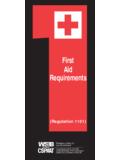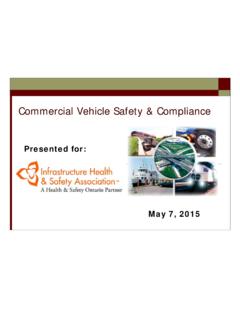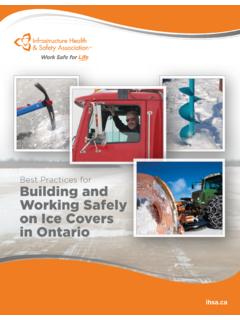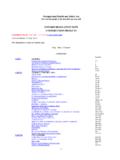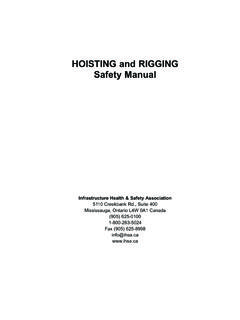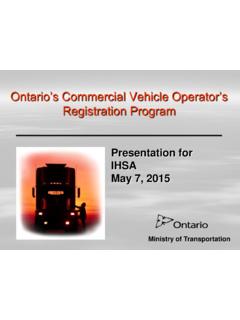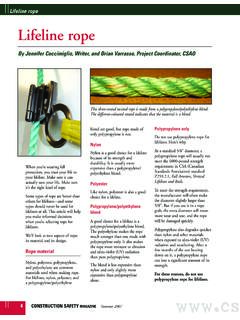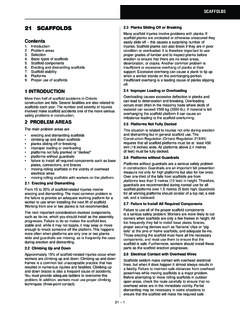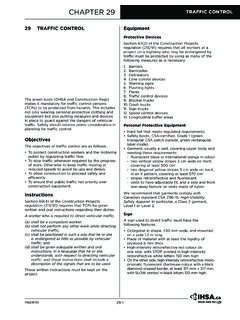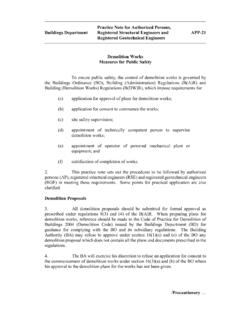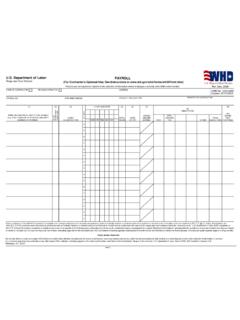Transcription of Civil Engineering Sector Labour-Management Health ... - …
1 PROCEDURE FOR THE STORAGE AND HANDLING OF FUEL ON CONSTRUCTION SITES Civil Engineering Sector Labour-Management Health and Safety Committee July 2008 PROCEDURE FOR THE STORAGE AND HANDLING OF FUEL ON CONSTRUCTION SITES PURPOSE The purpose of this document is to ensure vehicles, equipment, and vessels are fuelled safely on construction sites, to ensure fuel is stored safely on construction sites, and to protect the environment from spills and the hazards associated with spills. REFERENCES The information in this document is based on and in compliance with the Technical Standards and Safety Act, 2000 and the Technical Standards and Safety Authority s (TSSA) Liquid Fuels Handling Code, 2007. Main sections covering construction activities Section of the Liquid Fuels Handling Code, 2007: Dispensing requirements Mobile Fuelling Section of the Liquid Fuels Handling Code, 2007: Dispensing shall not take place within a) a building; b) 30 m of a stream, river, lake, canal or natural watercourse; c) 3 m of a property line; d) m of any opening in a building; or e) 3 m from any source of ignition.
2 Section of the Liquid Fuels Handling Code, 2007: The requirements of items (b) to (e) may be modified where the mobile refueller has an approved procedure to prevent a loss or escape of product from a) creating a hazard to public Health or safety b) contaminating any fresh water source or waterway c) interfering with the rights of any person, or d) entering into a sewer system or underground stream or drainage system. DEFINITIONS Constructor, as defined in the Occupational Health and Safety Act: A person who undertakes a project for an owner and includes an owner who undertakes all or part of a project by himself if by more than one employer. Employer, as defined in the Occupational Health and Safety Act: A person who employs one or more workers or contracts for the services of one or more workers and includes a contractor or subcontractor who performs work or supplies services and a contractor or subcontractor who undertakes with an owner, constructor, contractor or subcontractor to perform work or supply services.
3 Supervisor, as defined in the Occupational Health and Safety Act: Person in charge of a workplace or authority over a worker. Mobile fuelling, as defined in the Liquid Fuels Handling Code, 2007: The dispensing of fuel from a highway tank or mobile refuelling tank to a motor vehicle (including but not limited to forest and construction equipment, motorized snow vehicles, and other off-road vehicles), but not to a boat or the bulk storage tank on a highway tank. Mobile refuelling tanks, as defined in the Liquid Fuels Handling Code, 2007: Tanks that have been built in accordance with an approved standard and that may be mounted onto a truck, trailer, or skid for transporting product. Highway tank, as defined in the Liquid Fuels Handling Code, 2007: A tank that is attached to or forms a part of a truck or trailer and is loaded or unloaded without being removed from the vehicle.
4 Procedure: Procedure for The Storage and Handling of Fuel on Construction Sites. All other terms as defined in the Liquid Fuels Handling Code, 2007. RESPONSIBILITIES It is the primary responsibility of the Supervisor(s) to ensure that all fuel handling, dispensing, and storage is done in a safe and proper manner in accordance with this procedure. ENVIRONMENTAL PROTECTION PROCEDURES The accidental release of fuel during handling or dispensing may adversely affect the environment. The following protection procedures are intended to prevent a loss or escape of product and, in the event of a spill, to minimize the impact of the spill on the environment. DELIVERING AND DISPENSING FUEL Delivering fuel to the site Delivery of fuel to the site will be by approved highway tanks or mobile refuelling tanks.
5 Delivery may be into on-site mobile refuelling tanks or directly into the equipment. Transferring fuel from the supplying highway tank to an on-site highway tank will only be allowed if the on-site highway tank meets the requirements of the B620 standard and the refilling of the on-site highway tank is done in accordance with section of the Liquid Fuels Handling Code, 2007, which governs the loading and unloading of highway tanks and requires the use of a down spout to the bottom of the compartment for open dome loading, as well as bonding of the highway tank. Highway tanks shall be operated by a competent person. Dispensing fuel All dispensing or transferring of fuel will be attended for the duration of the operation.
6 The attendant must be aware of proper fuel handling procedures to minimize the risk of a spill and shall continuously scan the area adjacent to the fuelling operation for possible leaks or spills. The transferring and dispensing of fuel will be done with pumping equipment, an approved hose, and top-fill nozzle. When fuelling under the conditions of Section (a), (b), (c), (d), or (e) of the Liquid Fuels Handling Code, 2007 (see Reference section in this document), absorbent pads are to be placed around the fuel inlet prior to dispensing. Ensure that a site-appropriate spill containment kit is readily available. When unreeling the fuel transfer hose and nozzle, the nozzle must be in the upright position. The nozzle shall be kept clear of the ground when returned to the reel or storage position.
7 Verify that there is a proper connection between the fuel fill hose and the fill pipe of the highway tank, mobile refuelling tank, or the equipment being filled. Verify that the fill valve is open. The transfer of fuel must be stopped prior to overflowing, leaving room for expansion. Mobile refuelling tanks and fuel tanks on vehicles and equipment are not to be overfilled. The operation of moving equipment in the immediate area of a fuelling operation shall be suspended. Welding and/or burning operations within 3 metres must be stopped while fuelling is in progress. Maintain regular inspections of fuel systems and their components. Check for leakage, deterioration, or damage, in accordance with the Construction Regulation.
8 Additional dispensing requirements for marine operations Section of the Liquid Fuels Handling Code, 2007: Dispensing operations Marinas At a marina, product shall not be dispensed to fuel a watercraft while a) its engine is running; b) any source of ignition is present within 3 m of the dispensing nozzle where it enters the tank to be refueled; and c) there is a source of ignition on board the watercraft being refueled. Portable containers shall not be filled while located on a watercraft. Caution: This section is intended for the mobile fuelling of equipment on a watercraft not for the mobile fuelling of a watercraft. The Liquid Fuels Handling Code, 2007 prohibits the mobile fuelling of all watercraft. Secure barge or marine vessel on which the equipment to be fuelled is mounted to the work platform or wharf with proper marine lines.
9 Prior to transferring fuel to a mobile refuelling tank on a barge or to barge-mounted equipment, establish direct communication between the highway tank operator or mobile fuelling attendant and the marine operator. This shall be maintained until fuelling is complete. Where it is necessary to transfer a mobile fuelling tank from the wharf or work platform to a barge, or from one barge to another, the tank shall be engineered for lifting and equipped with proper lifting points and lifting tackle. The transfer shall be done with hoisting equipment in accordance with normal safety procedures. During marine fuelling operations, the attendant shall be particularly vigilant in scanning the water area adjacent to the fuelling operation for possible leaks or spills.
10 Spills Preventative measures are the best means of avoiding an accidental release of petroleum products. However, in the event of an accidental release, the following will occur: The Constructor will have appropriate spill response equipment available for all phases of the project area. See Appendix A for a list of such equipment. Cleanup action will follow the spill contingency plan. See Appendix B for a sample spill contingency plan. All spills or suspected spills of petroleum products, on land or into the water, regardless of size, will be reported immediately to the Supervisor. The Supervisor will report the spill immediately to the Project Manager, or his delegate, who shall ensure notification of the appropriate authorities.
